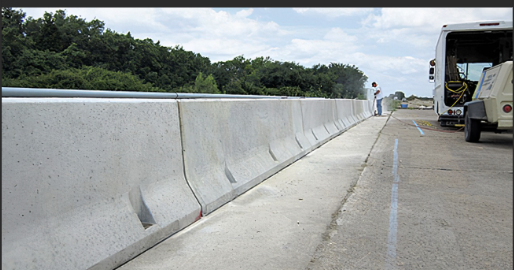When road construction begins, safety is a top priority for both drivers and workers. Concrete road barriers play a key role in protecting everyone involved by separating construction zones from active traffic and reducing the risk of accidents. With sturdy barriers in place, vehicles are guided safely away from the work area, preventing collisions and potential injuries.
The barriers act as physical shields, designed not just to keep traffic away from construction sites but also to absorb the impact if a vehicle does veer off course. They direct the vehicle back onto the road, minimizing damage. The durable design of these barriers ensures they can withstand high-speed impacts, providing peace of mind to both drivers and workers nearby.
Additionally, the use of concrete barriers on highways and busy roads makes construction sites safer for those working in hazardous conditions. By effectively defining the work zone, these barriers help maintain a safe distance between workers and moving vehicles, reducing exposure to harm. Explore more about the purpose and benefits of concrete barriers in traffic management on sites, which offers insights about concrete road barriers.
Fundamentals of Concrete Barrier Functionality
Concrete barriers are integral to road safety. They protect both drivers and workers by reducing the impact of collisions, redirecting vehicles, and providing a secure area during road construction projects.
Collision Mitigation and Energy Absorption
Concrete barriers are built to handle crashes with various vehicles. When a vehicle hits a barrier, the barrier absorbs some of the crash energy. This energy absorption reduces the force felt by vehicle occupants.
The design of these barriers ensures they disperse energy to minimize damage. They are made using durable materials to resist the impact and prevent vehicles from breaking through.
Barriers need to have the right height and width to be effective. For instance, a concrete barrier must be at least 815 mm (32 inches) tall to redirect vehicles properly.
Vehicle Redirecting Capabilities
When a vehicle hits a barrier, it often gets redirected back onto the road. This process prevents vehicles from veering into oncoming traffic. A well-known design for this purpose is the Jersey barrier, which features a sloped profile.
These barriers have a specific shape to guide vehicles back safely. The slope allows vehicles to ride up slightly and safely redirect.
This type of design reduces the chance of a vehicle flipping. Keeping the vehicle upright is important to avoid further crashes or injuries.
Protection Principles for Work Zones
In work zones, concrete barriers create a safe space between traffic and workers. They act as a shield to protect workers from vehicles. This protection is required in busy or hazardous areas.
Barriers need to be visible and strong. Using bright colors or reflective materials increases visibility for drivers.
Work zone barriers also must be easy to place and remove as construction progresses. Concrete barriers are chosen for their ability to withstand repeated impacts, keeping workers safe throughout the construction phase.
Correct and thoughtful placement of these barriers guarantees maximum safety for everyone on the road. Proper barrier systems help prevent accidents, protecting both the people in vehicles and those working on the road.
Design and Implementation Strategies
When designing and implementing concrete barriers for road construction, it is important to consider different types of barriers, basic performance standards, and how barriers can be adapted to specific sites. These elements contribute to effective barrier use and improved safety for both drivers and workers.
Barrier Types and Material Composition
Concrete barriers come in various designs that cater to different safety needs. Some common types include the NJ-shape and the F-shape, which are designed to redirect vehicles upon impact, reducing the risk of rollovers. These shapes lift the vehicle slightly, aiding in crash mitigation.
Material composition also plays a significant role. Most barriers are made from reinforced concrete, providing the durability and strength required to withstand collisions. Their design aims to minimize vehicle damage while protecting occupants. Some barriers may include steel reinforcements for additional support. Understanding the types and materials helps choose the right barrier for specific situations.
Standards for Barrier Performance
Barrier performance standards guarantee safety and reliability. Guidelines, often based on crash testing, determine the barriers’ effectiveness in preventing vehicles from crossing into work zones or opposing lanes. Current design guidelines have evolved to address both the demand and capacity sides, although updates are still necessary to match modern vehicle characteristics.
Testing methods like those specified in ENV 1317-4 for terminals and transitions evaluate how well barriers handle crashes. Performance gets assessed at various impact speeds and angles to guarantee they meet safety needs. Meeting these standards is key to maintaining safe construction zones.
Site-Specific Adaptations
Adapting barriers to specific construction sites is important for maximizing safety. Factors such as road geometry, traffic flow, and environmental conditions dictate how barriers should be placed. For instance, in areas with limited space, shorter barriers might be used, while longer barriers may be deployed in open, high-speed zones.
Adjustments in height and length depend on the risk factors present at the site. Engineering teams need to evaluate load capacities and external influences like wind or water flow to ensure the barrier remains stable. Site-specific designs help guarantee that barriers perform as needed in diverse conditions.
Conclusion
Concrete barriers are important in keeping drivers and workers safe during road construction projects. These barriers help manage traffic flow and minimize accidents by creating clear separations between work zones and moving vehicles.
Concrete Benefits:
- Durability: Withstands impact and protects work zones.
- Redirection: Directs vehicles back onto the path, reducing collision risks.
They also reduce disruption to traffic, allowing construction to progress smoothly. By using these protective measures, you are helping create safer and more efficient construction environments.



